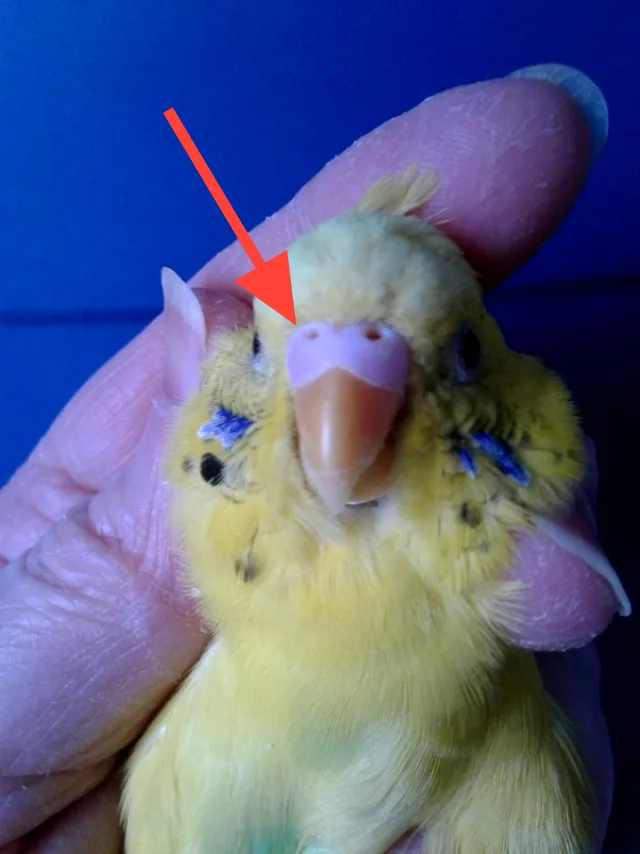During my ten years working in veterinary clinics, I noticed that the budgie’s cere color is a topic of debate among pet owners, both on identifing sex and health issues.
What is a cere, you may ask? It’s the fleshy, wax-like area where the beak meets the forehead of the bird.
It can be intriguing when it turns hues of purple.
There are several reasons why this may happen, some natural, others due to health concerns.
A budgie’s cere can turn purple in several situations.
In adult males, a purple cere is normal.
Young male and female budgies may also have a purple cere during their transition from pink to blue.
Certain genetic mutations can cause a purple cere in either sex.
Moreover, hormonal imbalances or diseases can also cause the cere to turn purple.
Male Adult Budgies Have A Purple, Light Purple, Dark Purple Cere Normally
A unique trait among male budgies is that their cere can take on different shades of purple, ranging from light to dark, particularly as they transition into adulthood.
This transformation is fundamentally driven by hormonal changes that occur during their life cycle.
These changes reflect the bird’s sexual maturity and readiness to mate.
However, note that individual variations can occur and some males may show different shades or a less intense color.
Such diversity only adds to the captivating charm of these delightful creatures.,
In addition to all these, the ceres of male budgies come to a bright ring during their heat period.
Young Male And Female Budgies Have A Purple Cere For A While (During The Color Transition From Pink To Blue)
Young males and females go through a phase where their cere, previously pink, transitions through a shade of purple before arriving at a definitive color.
This ‘purple phase’ is a normal part of their growth and signifies the onset of sexual maturity.
During this period, gender differentiation based on cere coloration becomes challenging, as both young males and females display a similarly hued purple cere.
However, this transient color change is merely a pit-stop on their journey towards adulthood.
As they continue to mature, the cere color stabilizes, with males typically developing a vibrant blue cere and females, a brown or tan one.
This period of color transformation is a testament to the intricate biological changes these captivating creatures undergo.
Some Genetic Mutations Allow Male Or Female Budgies To Have Purple Ceres
Nature is known for its incredible diversity and propensity for exceptions.
In the realm of budgies, this is no different.
Certain genetic mutations in these birds can result in purple ceres, irrespective of their gender.

This trait is intriguing because it defies the usual gender-specific cere colorations—typically blue for males and brown for females in adulthood.
These mutations result in male or female budgies retaining a purple cere, adding to the incredible diversity within the species.
Though these budgies represent a departure from the norm, they are nonetheless fascinating examples of the richness and unpredictability of genetic variation in the natural world.
Remember, these unique color presentations don’t signify anything amiss with the bird’s health.
These budgies are just as healthy and vivacious as their counterparts with more typical cere colors.
Hormonal Imbalances And Diseases That Cause Hormonal Disorders Such As Testicular Tumor And Sertoli Cell Tumor Causes Color Change Of Budgies’ Cere
Budgies, like all living creatures, can be susceptible to certain health conditions that affect their hormonal balance.
These hormonal imbalances can cause a wide range of symptoms, one of which can be changes in the color of the cere.
For instance, certain diseases can result in elevated levels of hormones, causing an unexpected change in cere color, including turning it purple or brown.
Such hormonal disorders can arise from various conditions, including but not limited to metabolic issues, glandular problems, or more severe health concerns like tumors.
It’s important to note that while a change in cere color could be a sign of a health problem, it is not a definitive indicator.
Any such concerns should prompt a consultation with a veterinarian.
This will allow for proper diagnosis and treatment, ensuring the optimal health and longevity of your feathered companion.

![Purple/Violet Budgies: Appearance, Breeding, [+PHOTOS]](https://www.petiska.com/wp-content/uploads/2022/07/purple-violet-budgies-appearance-breeding-photos-1656922763-400x300.jpg)
